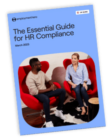First-time guide to hiring employees in the UK
Not sure how to go about hiring an employee? This step-by-step guide will walk you through the recruitment process while complying with UK legislation.

Are you a new business owner in the UK and looking to hire your first employee? Or a business owner looking to triple check your knowledge of the UK’s employment law?
If your business is currently growing, and you require additional help in running the day-to-day operations or expanding the business, we’re here to help ease you through the process of hiring an employee in the UK.
Employment can be a confusing and complex topic for new business owners, especially when it comes to hiring employees. Whether you’re looking for the right person to hire, or taking on the hiring process for the first time, we’ve got you covered with this handy guide to hiring employees in the UK.
Disclaimer: The information in this article is current as at 28 May 2022, and has been prepared by Employment Hero Pty Ltd (ABN 11 160 047 709) and its related bodies corporate (Employment Hero). The views expressed in this article are general information only, are provided in good faith to assist employers and their employees, and should not be relied on as professional advice. The Information is based on data supplied by third parties. While such data is believed to be accurate, it has not been independently verified and no warranties are given that it is complete, accurate, up to date or fit for the purpose for which it is required. Employment Hero does not accept responsibility for any inaccuracy in such data and is not liable for any loss or damages arising either directly or indirectly as a result of reliance on, use of or inability to use any information provided in this article.You should undertake your own research and to seek professional advice before making any decisions or relying on the information in this article.
What is employment law?
Employment law is the legal framework that you need to follow to make sure you’re employing people compliantly. There are a number of Acts in the UK which relate to employment, there is no single piece of legislation that covers every aspect of hiring and managing an employee.
Some of the legislation which forms part of the UK employment legal framework include;
Employment Act 2002, Employment Relations Act 2004, Employment Rights Act 1996, National Minimum Wage Act 1996, The Small Business, Enterprise and Employment Act 2015 — amongst many others.
Employment law is complex and also constantly evolving, so it’s important to keep up-to-date with the latest developments and speak to a legal professional if you are unsure how a new rule applies to your specific circumstances.
What are the consequences of not following employment law?
Just as there are different employment laws which apply to different situations, there is no one consequence to not following employment laws. Depending on which law a business is in breach of, they could find themselves in court or an employment tribunal, needing to pay compensation or fines, and facing reputational damage.
If there’s something we know for sure, it’s that most small business owners don’t get started with the dream of being an employer. However, knowing the employment law and making sure you’re hiring compliantly is an essential part of protecting and growing your business.
What are the legal requirements for hiring an employee?
So you’ve sorted through a list of qualified candidates, conducted a lengthy interview process, and now you’ve finally found the right person for the job! Congrats — you are now ready to onboard your first hire.
It’s natural to want to rush this process to get your perfect candidate in the door as soon as possible, but there are some important legal things to do first. Here is our non-exhaustive list of legal and non-legal obligations to be aware of, to get your first team member officially on the books.
Legal right to work
Before you officially hire someone and issue their offer letter and employment contract, you need to check the job applicant’s right to work in the UK. There are a couple of ways to do this, and it can be done via an online service.
As stated on gov.uk, “you could face a civil penalty if you employ an illegal worker and have not carried out a correct right to work check.” We recommend downloading the government’s right to work checks: an employer’s guide, to make sure that you are completing this process correctly.
For some roles, including roles where an employee is working with children or in healthcare, you may need to conduct a further background check to confirm someone’s employment eligibility. The main type of background check employers can access in England is called a Disclosure and Barring Service (DBS) check. Learn more about the DBS here. Different rules apply in Scotland and Northern Ireland.
Employment contracts
Employment contracts are a helpful tool to establish clear employment terms with your new hire. As defined on gov.uk, an employment contract is an agreement that sets out an employee’s employment condition, rights, responsibilities and duties.
In this sense, an employment agreement ensures that all applicable terms are captured in a clearer and certain manner. Employment contracts can help make sure that you and your employee are on the same page from day one.
The terms outlined in employment contracts must conform to the relevant applicable legislation. It may be helpful to consult an employment lawyer when you are writing up your first contract, to make sure that your terms are in line with all relevant rules. Learn more about how the government defines employment contracts.
Working hours
What kind of hours will your new employee work? Are they full-time, part-time or working casual hours? Details about an employee’s working hours should be outlined in their employment contract, and these must comply with laws on working hours.
Under the Working Time Regulations 1998, an employer must ensure that employees do not exceed 48 hours of work weekly. Workers are also entitled to 24 consecutive hours of rest per week. The period may be computed as two continuous days of rest per 14 days.
And when it comes to breaks; employees working for six hours or more are also entitled to a minimum of 20 minutes of rest break, away from their workplace.
These are just a couple of the rules that apply to working hours. You can find out more about working hours here — and always seek expert advice if you’re unsure about how the laws apply to your specific situation.
Salary and wages
How much will you be paying your new team member? The salary and wages for your new hires should also be outlined in their contract.
All wage agreements should comply with the national minimum wage at the time of hiring. The statutory minimum wages are governed by the National Minimum Wage Act 1988. The rates are determined by age, and rise annually on April 1. See the current National Minimum Wage and National Living Wage details here.
When it comes to actually getting the money in someone’s account, many small business owners use a payroll service or some kind of payroll software to help them work through the numbers. These need to follow certain obligations, which includes reporting to HM Revenue & Customs.
HM Revenue & Customs (HMRC) obligations
Before you hire your first employee, you need to register with HMRC as an employer, and get your PAYE (pay as you earn) employer reference number. Don’t leave this important step to when you’ve already hired your team member — you must register before your employee’s first payday and it can take up to five business days to receive your number.
PAYE is HMRC’s system to collect Income Tax and National Insurance contributions from employment. In most cases you will need to pay your employees through PAYE, and you can learn more about PAYE here.
You will then need to source information from your employee so that you can set them up with the correct tax code and starter declaration. You will need your new starter’s date of birth, gender, full address and start date.
From your employee’s P45 form, you will note their full name, leaving date from their last job,
total pay and tax paid to date for the current tax year, student loan deduction status, National Insurance number and existing tax code.
If you decide to run payroll yourself, you will need to use payroll software to report to HMRC. Payroll software can help you record your employees’ details, work out your employee’s pay and deductions, report payroll information to HMRC, work out how much you need to pay HMRC, and help you calculate statutory pay like maternity or sick pay.
Many payroll software providers also offer additional helpful features. Employment Hero’s HMRC-approved payroll software also offers automated payslips, time and attendance tools and rota management features.
Employers’ Liability insurance (EL)
Here’s another important step you need to complete before you hire employees. You must get Employers’ Liability (EL) insurance before you become an employer. If you aren’t properly insured, you could be hit with a daily fine.
As defined on gov.uk, “EL insurance will help you pay compensation if an employee is injured or becomes ill because of the work they do for you.”
Setting up pensions
A pension is a sum of money that employees accumulate throughout their working lives to support their retirement.
All employers must offer a workplace pension scheme by law and have a duty to automatically enrol anyone who is eligible. If you don’t pay the correct contributions on time to the staff pension scheme, you risk being fined by The Pensions Regulator (TPR).
To learn more about setting up pensions for your employees, visit The Pensions Regulator’s website.
Tips to improve your hiring process
You might be ahead of the game with the legal requirements of hiring your first employee, but looking for a helping hand when it comes to the hiring process for your very first staff member.
It can be an odd situation for a growing business. There’s no precedent for your hiring process, and no current employees to show off any kind of fledgeling company culture. At the same time, you want to get the hiring process right. The costs of hiring the wrong person can be high, which can do significant harm to an emerging business.
So how do you create a hiring process that can get you started on the right foot? We have some tips to help.
Write a high-impact job description
If you want to find the right people, you need to have an excellent job description (JD). Job descriptions aren’t your job postings — they’re documents that detail the role, the company, and job responsibilities.
Why should you focus on your job descriptions before advertising? Even though your candidates might not see the job description in full until they apply — everything in your recruitment process will be built around this document. A JD will inspire what goes into your job ad, and it will help you remember what you’re looking for in a new star hire.
A perfect job description will also leave the job seeker knowing that they are definitely right or wrong for the role. It can help the person decide if the position aligns with their skills, values and interests, helping them (and you) save time if they don’t want to go further.
Never written a job description before? Download our free template for a standout job description. And if you’re happy with your JD and ready to advertise on job sites, take a look at our free ideal job ad template.
Be thoughtful with your interview questions
In today’s tough recruitment market, job seekers have the power of choice. As a first time employer, it’s good to learn early that job candidates are interviewing you as much as you’re interviewing them.
If you take a hard line approach, like asking trick questions or challenging the interviewee more than necessary, you could lose your best candidates to other opportunities.
To make sure this doesn’t happen, think about your ideal candidate and what they want in a role. Seeing it from this dual perspective can help you find balanced questions that could better appeal to the right candidates and their career objectives.
Streamline your recruitment process
Another common mistake when hiring an employee is dragging out the recruitment process. In such a competitive job market, it’s important to be conscious of the candidate’s time and schedule.
If the candidate’s contact details or applications are getting lost, getting called back for excessive rounds of interviews, or getting different messages from various people within the business — they’re going to get frustrated, real fast.
From an employer’s standpoint, you should also want to get your new hire on the books as soon as possible (remember those recruitment costs that we talked about earlier?).
Make the process easier for everyone by using a tool like an Applicant Tracking System (ATS). Not only does our ATS post your job ad to leading job boards across the world, but it also has an easy-to-use employee pipeline that can track your candidate from application to job offer. Securely storing your applicants’ details, interview notes and documents — an ATS makes hiring paperwork so much easier to manage.
What’s next in the hiring process? Are you ready to welcome a new employee?
Now that you’ve got all the information you need from this guide to hiring an employee, and have successfully made your first hire, you’ll want them to have an awesome employee experience – especially during their first week at work! Here are some ideas to help guide you on how to structure and prepare for their onboarding process.
- Create an onboarding checklist.
- Greet them on their first day with a welcome pack.
- Pair them up with a buddy or mentor.
Want more tips on how you can create a great employee onboarding process? Download our comprehensive guide to onboarding employees today.
And what about hiring beyond UK borders?
Do you need to hire someone outside of the UK to support your business? That comes with a whole other layer of complexity!
Our Global Teams service makes international hiring compliance a breeze. Learn more about how you can hire your first international employee with Global Teams now.
Related Resources
-
 Read more: Employment Rights Bill Timeline: Key Dates for Employers
Read more: Employment Rights Bill Timeline: Key Dates for EmployersEmployment Rights Bill Timeline: Key Dates for Employers
The UK Employment Rights Bill is coming. Discover the key dates from 2026 to 2027, and learn how to prepare…
-
 Read more: 7 common types of leadership styles and how to find yours
Read more: 7 common types of leadership styles and how to find yours7 common types of leadership styles and how to find yours
Learn the 7 most common types of leadership styles, their strengths and how to identify your own – with guidance…
-
 Read more: Unauthorised Absence From Work: A Complete Guide
Read more: Unauthorised Absence From Work: A Complete GuideUnauthorised Absence From Work: A Complete Guide
Absences that aren’t authorised can disrupt productivity & morale. Learn to manage them effectively, comply with employment law & prevent…












